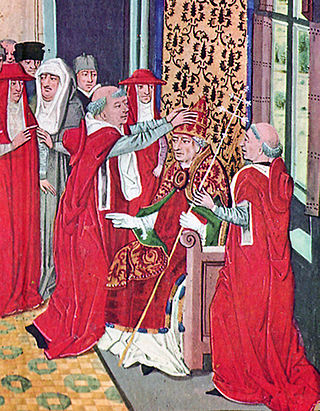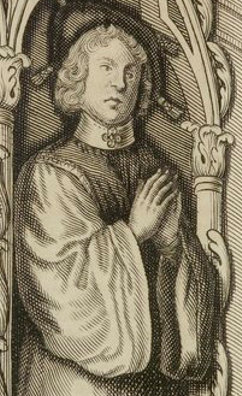
Étienne Baluze, known also as Stephanus Baluzius, was a French scholar and historiographer.

The County of Boulogne was a county within the Kingdom of France during the 9th to 15th centuries, centred on the city of Boulogne-sur-Mer. It was ruled by the counts of Flanders in the 10th century, but a separate House of Boulogne emerged during the 11th century. It was annexed by Philip II of France in 1212, after which it was treated as part of the county of Artois until it was finally annexed into the royal domain in 1550.

Hélie de Talleyrand-Périgord was a French Cardinal, from one of the most aristocratic families in Périgord, south-west France. Hélie was born at Périgueux, third son of Elias VII, Count of Périgord, and Brunissende of Foix, daughter of Roger Bernard III, comte de Foix. His elder brothers were Archambaud (IV), who inherited the County, and Roger-Bernard ; his younger brother was Fortanier, and his sisters were Agnes, Jeanne, Marguerite, and Rosemburge. As a third son Hélie was destined for an ecclesiastical career. His brother, Roger Bernard, too, had an ecclesiastical career, becoming Canon of Lyon. But then, the eldest son died, and Roger-Bernard became the Count of Périgord. Hélie became a major figure in the Avignon papacy, and also a diplomat engaged in the negotiations of the Hundred Years' War, having friendships in both English and French royal families. In his last months he had been appointed Papal Legate for a crusade against the Turks.
Jean IV de Bueil was lord of Bueil-en-Touraine, son of Jean III de Bueil.

Emmanuel-Théodose de La Tour d'Auvergne, cardinal de Bouillon was a French prelate and diplomat.
Jean VIII of Harcourt was a count of Aumale. He was the son of John VII of Harcourt, count of Harcourt, and of Marie of Alençon, a "princess of the blood".

Bianca of Burgundy, was a Countess consort of Savoy by marriage to Edward, Count of Savoy. She was the mother of Joan of Savoy.

Guy of Boulogne was a statesman and cardinal who served the Avignon Papacy for 33 years. He participated in the papal conclaves of 1352, 1362 and 1370, and was the Subdean of the Sacred College of Cardinals. His diplomatic postings were extensive, including Hungary, Italy, and Spain. He headed an effort to end the Hundred Years' War. The historian Kenneth Setton called him "one of the commanding figures of his day, and the letters of Petrarch abound with references to him".

Count of Boulogne was a historical title in the Kingdom of France. The city of Boulogne-sur-Mer became the centre of the county of Boulogne during the ninth century. Little is known of the early counts, but the first holder of the title is recorded in the 11th century.
Frances de Châtillon was Countess of Périgord, Viscountess of Limoges, and Dame of Avesnes and Châlus.
William was Seigneur de Avesnes and Viscount of Limoges from 1404 until his death. He was also briefly Count of Périgord following the death of his brother John II, Count of Penthièvre, in 1454.

William XI or William XII was the Count of Auvergne and Boulogne from 1277 until his death no later than 1279.
William of Auvergne was a French nobleman and clergyman who was elected prince-bishop of Liège during a disputed election in 1281 but was forced to renounce the office the following year.

William X or IX was the count of Auvergne from 1222 until his death.

Robert VII of Auvergne was count of Auvergne and Boulogne from 1317 until his death.

Robert V of Auvergne was count of Auvergne from 1247 and Boulogne from 1265 until his death.

Robert VI of Auvergne was count of Auvergne and Boulogne from 1277 until his death.
Bertrand V was lord of La Tour from 1423 and count of Auvergne and Boulogne from 1437 until his death.

Bertrand VI was lord of La Tour and count of Auvergne from 1461until his death. He was also count of Boulogne from 1461 to 1477, when he exchanged that title for the county of Lauragais, which he held for the remainder of his life.













